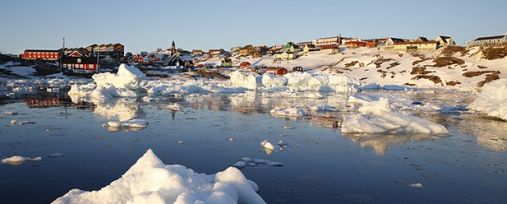No location could have been more fitting than the Ilulissat Icefjord for top-level researchers from many countries to meet and discuss climate change and the fate of the world’s land ice, particularly the Greenland Ice Sheet. The Ilulissat Glacier at is the Northern Hemisphere’s most productive glacier. Due to its continual calving, the fjord and ocean off Ilulissat are always dotted with icebergs.
Deeper understanding of ice
Nearly 200 eminent Nordic and international researchers participated in the conference. Ongoing observations confirm the accelerating changes taking place in the Greenland and

Arctic cryosphere (land ice, sea ice and permafrost). In recent years the cryospheric knowledge base has grown and a great deal of new data and information has been collected. Satellite data from the European Space Agency (ESA), aerial observations and ground-based monitoring stations are compiled and compared to acquire the best possible overview of what is happening to the land ice.
The project leader for the Nordic Centre of Excellence (NCoE) SVALI is Professor Jon Ove Hagen of the University of Oslo. He is very pleased with the results generated by SVALI since its launch five years ago.
“This conference illustrates the achievements of SVALI,” says Professor Hagen. “Theoretical modelling and multiple types of observations can now be viewed in context with one another. Previously they were seen more as separate areas, but now we have managed to link them together. These are exciting results and we are better informed today about what is taking place in the Arctic than we were five years ago. It is important to take an interdisciplinary approach, and looking ahead we need to think even more along interdisciplinary lines.”
“The NCoE SVALI has also given rise to new networks between researchers and research groups that will continue after the SVALI projects are wrapped up and the final report is delivered in March 2016. In addition, SVALI has opened up new career opportunities for many younger researchers, which has always been a key aim,” explains Professor Hagen. A Memorandum of Understanding has also been signed between the participating universities to continue the Ph.D. courses after SVALI is concluded.

New business Development
A number of Greenland’s politicians, interest groups and other representatives of Greenland’s inhabitants attended the conference. Jørgen Hammeken-Holm, Acting Deputy Minister of Greenland’s Ministry of Mineral Resources, described climate change as positive in that emerging new industries can provide Greenland with greater opportunities for development and growth. There is political will for petroleum recovery and many licences have been granted to petroleum companies. Operations are not yet ready for start-up, however, due to three main factors: ice conditions, costs and a lack of confirmed discoveries. Weather conditions are another challenge, and security issues regarding the area’s vulnerable ecosystems have not been solved. Another benefit to climate change is that viable agriculture could become more widespread in southern parts of Greenland. Tourism is another industry in growth, but there are concerns about negative impacts on the climate and environment.

Dialogue with inhabitants
The opening day of the conference was open to everyone. Several local residents expressed their view that the researchers should maintain a dialogue with them, particularly with the experienced, older inhabitants who deal with the practical impacts of climate change on a daily basis. Their point was that this experience could be incorporated into research activities as an additional source of information and observations to supplement satellite data and measurements taken from aircraft and ground stations. Inhabitants also experience the far-reaching effects on conditions for traditional industries such as fishing and hunting, and can report that new species which they have never seen before are entering their local waters.
SVALI, which stands for Stability and Variations of Arctic Land Ice, is one of six Nordic Centres of Excellence under the Top-level Research Initiative. SVALI has 18 partners and combines the skills of experienced researchers and many younger research scientists and post-doctoral researchers.
This article is published first time on the webpages of NordForsk; Arctic researchers met at a glacier 11.6.2015, and republished With permission from NordForsk.
Article written by: Anne Riiser
Photo: Anne Riiser and Terje Heiestad
